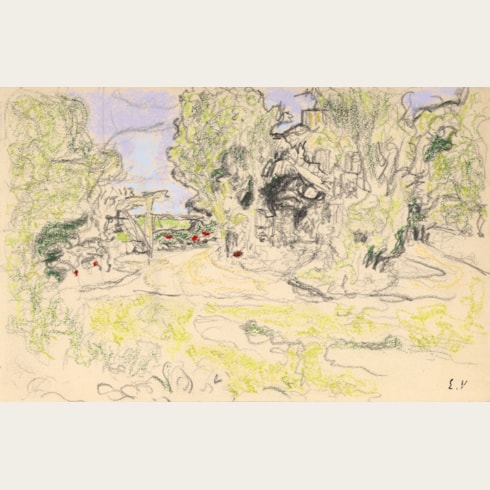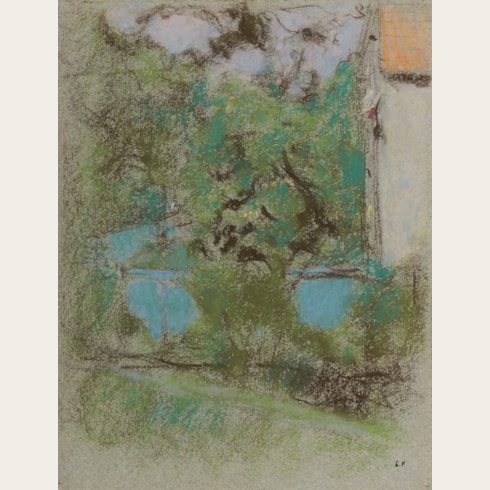Edouard VUILLARD
(Cuiseaux 1868 - La Baule 1940)
Jos Hessel in the Drawing Room at the Château des Clayes
Signed E Vuillard at the lower right.
305 x 224 mm. (12 x 8 3/4 in.)
As one scholar has described him, ‘Jos Hessel was one of the first art dealers of a kind that is familiar today: he sought out gifted contemporaries, found patrons and commissions for them, and looked after their interests in general…As an impresario, Hessel was energetic and resourceful and made himself indispensable. Shortly after 1900 Vuillard and the Hessels became inseparable, spending almost every evening together in the Hessels’ Paris apartment. During the summer Vuillard traveled or went to Brittany and Normandy with them, and in later years he became a semipermanent guest at their country houses on the outskirts of Paris.’ The Hessels moved to the Château des Clayes in 1926, and Vuillard was to become a frequent visitor to the house, where he had his own room. Indeed, Les Clayes, conveniently close to Paris and with its large park designed by André Le Nôtre, became the artist’s rural retreat for the last decade of his life. As Kimberly Jones has noted, ‘The time he spent away from Paris in the countryside was essential to Vuillard’s productivity; it offered him repose, but also a change of scenery that helped expand his own perceptions of the world around him.’
In later years Jacques Salomon, the artist’s nephew by marriage, recalled of Vuillard at Les Clayes that ‘he was constantly drawing his friends, and those who found his eye upon them knew they must hold the pose in which he had caught them...I can still picture Vuillard at a social gathering. He would suddenly look intently at a group...with a direct stare. Then his face would grow grave, and without taking his eyes off his subjects he would whip his notebook out of his pocket...and, without hesitation, start to draw. He worked with great speed, scarcely glancing at his paper, entirely preoccupied by the sight before him.’
The large canvas seen here hanging above the fireplace behind the seated figure of Jos Hessel is a painting of The Sleeping Diana of c.1924 by Ker-Xavier Roussel, Vuillard’s brother-in-law and fellow Nabis. The painting, which can be seen in photographs of the interior of Les Clayes in 19307, was destroyed in a fire at the château in 1944. An oil sketch for the painting is today in the collection of the High Museum of Art in Atlanta, Georgia. Also seen in the present sheet, on top of the mantlepiece, is a small bust by the sculptor Aristide Maillol. The bust, which would appear to be a portrait of Lucy Hessel, recently appeared at auction in Paris.
Vuillard’s domestic interior scenes, which usually include members of his family and close friends, as one scholar notes, ‘are not intended as portraits, nor are they genre paintings in the true sense of the term. Rather, they are evocations of the private world of the artist’s personal experience...[and] provide a tantalizing view into a cloistered and rarefied world…’ A stylistically comparable pastel by Vuillard depicting the top of the mantlepiece and the Maillol bust, with the Roussel painting behind, was on the art market in c.2004.
The present sheet belonged to the Hessels and was inherited by their adopted daughter Lulu Grandjean-Hassel, later Mme. Jacques Arpels (1921-2004), who appears in many of Vuillard’s paintings, drawings and photographs after 1930.
At the start of his career, Edouard Vuillard joined a group of young artists - including Maurice Denis, Paul Sérusier, Pierre Bonnard and Kerr-Xavier Roussel - who called themselves the Nabis and were united by a desire to develop a new, more expressive pictorial language, inspired by the work of Paul Gauguin. In the 1890's, Vuillard began receiving a number of private commissions for wall panels intended to decorate the rooms of private houses. This was a genre in which he was to become very successful, and between 1892 and 1901 he painted a number of these large-scale panneaux décoratifs, almost all the result of commissions from a small group of mutual friends and enlightened collectors. Vuillard’s work of this type remained largely unknown to the public at large until several panels were exhibited at the Salon d’Automne in 1905.
In the early years of the new century, enjoying the fruits of a commercial arrangement with the Galerie Bernheim-Jeune, Vuillard began expanding his repertoire of decorative panels and small, intimiste domestic interiors to include portraits and landscapes. Although his work as a peintre-décorateur was largely confined to private homes, he did receive a handful of public commissions, including the decoration of the foyer of the newly built Théâtre des Champs-Elysées in 1912. The later years of his career found Vuillard saw mainly as a portrait painter, often depicting his sitters within an interior setting. He rarely exhibited in public after 1914, and it was not until a large retrospective exhibition of his work was held at the Musée des Arts Décoratifs in Paris in 1938, two years before his death, that interest in Vuillard was renewed.
As a modern scholar has noted, ‘Vuillard was in many ways the supreme graphic artist among the Nabis. He drew throughout his life, indeed daily...’ From around 1900 onwards he used mainly pastel for his drawings, and came to master the subtlety and vibrancy of this challenging medium. In one of the first monographs on the artist, the critic and art historian Claude Roger-Marx wrote that, ‘Vuillard often found expression by means of pastels’, and he made more extensive use of the pastel medium than perhaps any French artist since Degas in the previous generation. Pastel was to become an essential part of Vuillard’s working process until the end of his career, and was used for landscape and figure studies, compositional drawings, still life subjects and as preparatory studies for portraits.
Provenance
By descent to their daughter, Lucie (Lulu) Grandjean-Hessel (Mme. Jacques Arpels), Paris
Thence by descent.
Literature




















